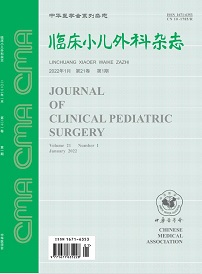Zhao Xing,Deng Changkai,Peng Qiang,et al.Significance of changes in maximum urinary flow rate in boys with genital lichen sclerosus[J].Journal of Clinical Pediatric Surgery,,():39-44.[doi:10.3760/cma.j.cn101785-202207032-008]
Significance of changes in maximum urinary flow rate in boys with genital lichen sclerosus
- Keywords:
- Lichen Sclerosus; Urinary Flow Rate; Surgical Procedures; Operative; Child
- Abstract:
- Objective To summarize the clinical data with genital lichen sclerosus (GLS) and explore the significance of maximum urinary flow rate in its diagnosis and management. Methods This retrospective study analyzed clinical data from 41 boys diagnosed with GLS and treated surgically at the Department of Urology,Chengdu Women’s and Children’s Central Hospital between April 2020 and June 2021.Patients were grouped by urinary difficulty (urinary difficulty group,n=16; no urinary difficulty group,n=25),preoperative corticosteroid use (preoperative corticosteroid group,n=11; no preoperative corticosteroid group,n=30),postoperative corticosteroid use (postoperative corticosteroid group,n=6; no postoperative corticosteroid group,n=35),and urethral meatus involvement (involvement group,n=4; no involvement group,n=37).Preoperative and postoperative maximum urinary flow rates were recorded and compared among groups. Results A total of 41 cases met pathological diagnostic criteria.Maximum urinary flow rate significantly improved from preoperative (10.88±4.26) mL/s to 1 month (14.44±4.02) mL/s,3 months (16.84±2.69) mL/s,6 months (18.28±3.76) mL/s,and 12 months (17.60±2.57) mL/s postoperatively (P<0.05).Preoperatively,21 patients had abnormal maximum urinary flow rate,which decreased to 6 cases at 1 month postoperatively and resolved completely at 3,6,and 12 months.The preoperative corticosteroid group showed no significant difference in normalized maximum urinary flow rates at 1 month postoperatively compared to the non-corticosteroid group.The postoperative corticosteroid group had significantly fewer cases of normalized maximum urinary flow rates at 1 month compared to the non-corticosteroid group .Similarly,the urethral meatus involvement group showed fewer normalized maximum urinary flow rate cases at 1 month postoperatively compared to the non-involvement group . Conclusions Surgical treatment improves postoperative maximum urine flow rate in boys with GLS.Preoperative use of corticosteroid ointments may not improve postoperative maximum urinary flow rate but can serve as an adjunct therapy for patients with abnormal maximum urinary flow rates.Maximum urinary flow rate can be considered an important reference indicator for assessing voiding function in children with GLS.
References:
[1] 王林, 撒应龙.男性生殖器硬化性苔藓样变的临床诊疗进展[J]. 现代泌尿外科杂志, 2016, 21(8):645-648.DOI:10.3969/j.issn.1009-8291.2016.08.019. Wang L, Sa YL.Clinical progress in the diagnosis and treatment of male genital lichen like sclerosis[J]. J Mod Urol, 2016, 21(8):645-648.DOI:10.3969/j.issn.1009-8291.2016.08.019.
[2] 陈月娇, 郑杰文, 王学军, 等.男童外生殖器硬化性萎缩性苔藓的临床病理表现及治疗[J]. 中华医学杂志, 2017, 97(44):3498-3500.DOI:10.3760/cma.j.issn.0376-2491.2017.44.013. Chen YJ, Zheng JW, Wang XJ, et al.Clinical and pathological manifestations and treatment of sclerosing atrophic lichen in male external genitalia[J]. Natl Med J China, 2017, 97(44):3498-3500.DOI:10.3760/cma.j.issn.0376-2491.2017.44.013.
[3] 赵冬艳, 唐达星, 徐珊, 等.干燥性闭塞性龟头炎儿童时期发病特点分析[J]. 临床小儿外科杂志, 2018, 17(1):34-37.DOI:10.3969/j.issn.1671-6353.2018.01.009. Zhao DY, Tang DX, Xu S, et al.The incidence of balanitis xerotica obliterans in children[J]. DOI:10.3969/j.issn.1671-6353.2018.01.009.
[4] Kiss A, Király L, Kutasy B, et al.High incidence of balanitis xerotica obliterans in boys with phimosis:prospective 10-year study[J]. Pediatr Dermatol, 2005, 22(4):305-308.DOI:10.1111/j.1525-1470.2005.22404.x.
[5] Li JF, Deng CK, Peng Q.Underestimation of genital lichen sclerosus incidence in boys with phimosis:results from a systematic review[J]. Pediatr Surg Int, 2018, 34(11):1245-1250.DOI:10.1007/s00383-018-4357-7.
[6] Folaranmi SE, Corbett HJ, Losty PD.Does application of topical steroids for lichen sclerosus (balanitis xerotica obliterans) affect the rate of circumcision? A systematic review[J]. J Pediatr Surg, 2018, 53(11):2225-2227.DOI:10.1016/j.jpedsurg.2017.12.021.
[7] Kiss A, Csontai A, Pirót L, et al.The response of balanitis xerotica obliterans to local steroid application compared with placebo in children[J]. J Urol, 2001, 165(1):219-220.DOI:10.1097/00005392-200101000-00062.
[8] Lindhagen T.Topical clobetasol propionate compared with placebo in the treatment of unretractable foreskin[J]. Eur J Surg, 1996, 162(12):969-972.
[9] Singh L, Sengar M, Goyal S, et al.Childhood phimosis secondary to lichen sclerosus:is there a spatial pattern of histopathological changes?[J]. Am J Dermatopathol, 2018, 40(11):824-828.DOI:10.1097/DAD.0000000000001248.
[10] Rosier PFWM, Schaefer W, Lose G, et al.International continence society good urodynamic practices and terms 2016:urodynamics, uroflowmetry, cystometry, and pressure-flow study[J]. Neurourol Urodyn, 2017, 36(5):1243-1260.DOI:10.1002/nau.23124.
[11] Yang SS, Chiang IN, Hsieh CH, et al.The Tzu Chi nomograms for maximum urinary flow rate (Qmax) in children:comparison with Miskolc nomogram[J]. BJU Int, 2014, 113(3):492-497.DOI:10.1111/bju.12425.
[12] 文建国, 童尔昌.小儿尿流测定及其临床意义[J]. 中华小儿外科杂志, 1990, 11(1):29-31.DOI:10.3760/cma.j.issn.0253-3006.1990.01.120. Wen JG, Tong EC.Pediatric urinary flow measurement and its clinical significance[J]. Chin J Pediatr Surg, 1990, 11(1):29-31.DOI:10.3760/cma.j.issn.0253-3006.1990.01.120.
[13] Catterall RD, Oates JK.Treatment of balanitis xerotica obliterans with hydrocortisone injections[J]. Br J Vener Dis, 1962, 38(2):75-77.DOI:10.1136/sti.38.2.75.
[14] Bochove-Overgaauw DM, Gelders W, De Vylder AMA.Routine biopsies in pediatric circumcision:(non) sense?[J]. J Pediatr Urol, 2009, 5(3):178-180.DOI:10.1016/j.jpurol.2008.11.008.
[15] Homer L, Buchanan KJ, Nasr B, et al.Meatal stenosis in boys following circumcision for lichen sclerosus (balanitis xerotica obliterans)[J]. J Urol, 2014, 192(6):1784-1788.DOI:10.1016/j.juro.2014.06.077.
[16] Van Batavia JP, Combs AJ.The role of non-invasive testing in evaluation and diagnosis of pediatric lower urinary tract dysfunction[J]. Curr Urol Rep, 2018, 19(5):34.DOI:10.1007/s11934-018-0784-1.
[17] Van Batavia JP, Combs AJ, Fast AM, et al.Use of non-invasive uroflowmetry with simultaneous electromyography to monitor patient response to treatment for lower urinary tract conditions[J]. J Pediatr Urol, 2014, 10(3):532-537.DOI:10.1016/j.jpurol.2013.11.015.
[18] Arena S, Russo T, Impellizzeri P, et al.Utility of uroflowmetry during the follow-up of children affected by balanitis xerotica obliterans (BXO)[J]. Arch Ital Urol Androl, 2018, 90(2):123-126.DOI:10.4081/aiua.2018.2.123.
Memo
收稿日期:2022-7-17。
基金项目:成都市医学科研项目(2019017)
通讯作者:邓常开,Email:295969893@qq.com
